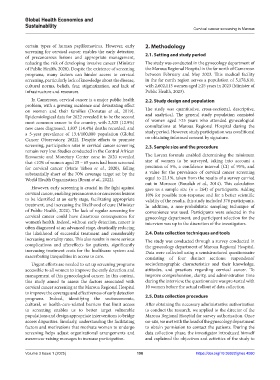Page 206 - GHES-3-1
P. 206
Global Health Economics and
Sustainability
Cervical cancer screening in Maroua
certain types of human papillomavirus. However, early 2. Methodology
screening for cervical cancer enables the early detection
of precancerous lesions and appropriate management, 2.1. Setting and study period
reducing the risk of developing invasive cancer (Minister The study was conducted in the gynecology department of
of Public Health, 2020). Despite the existence of screening the Maroua Regional Hospital in the far north of Cameroon
programs, many factors can hinder access to cervical between February and May 2023. This medical facility
screening, particularly lack of knowledge about the disease, in the far north region serves a population of 5,178,810,
cultural norms, beliefs, fear, stigmatization, and lack of with 2,602,113 women aged ≥25 years in 2023 (Minister of
infrastructure and resources. Public Health, 2023).
In Cameroon, cervical cancer is a major public health 2.2. Study design and population
problem, with a growing incidence and devastating effect
on women and their families (Donatus et al., 2019). The study was quantitative, cross-sectional, descriptive,
Epidemiological data for 2022 revealed it to be the second and analytical. The general study population consisted
most common cancer in the country, with 2,525 (12.9%) of women aged ≥25 years who attended gynecological
new cases diagnosed, 1,837 (14.4%) deaths recorded, and consultations at Maroua Regional Hospital during the
a 5-year prevalence of 13.4/100,000 population (Global study period. However, study participation was conditional
Cancer Observatory, 2022). Despite efforts to promote on obtaining informed consent by signature.
screening, participation rates in cervical cancer screening 2.3. Sample size and the procedure
remain very low. Studies conducted in the Central African
Economic and Monetary Center zone in 2020 revealed The Lorenz formula enabled determining the minimum
that <10% of women aged 25 – 65 years had been screened size of women to be surveyed, taking into account a
for cervical cancer (Marie Tebeu et al., 2020), falling precision of 5%, a confidence interval (CI) of 95%, and
substantially short of the 70% coverage target set by the a value for the prevalence of cervical cancer screening
World Health Organization (Bruni et al., 2022). equal to 22.1%, taken from the results of a survey carried
out in Morocco (Bouslah et al., 2014). This calculation
However, early screening is crucial in the fight against gave us a sample size (n = 264) of participants. Adding
cervical cancer, enabling precancerous or cancerous lesions 10% for possible non-response and for a better scientific
to be identified at an early stage, facilitating appropriate validity of the results, this study included 376 participants.
treatment, and increasing the likelihood of cure (Minister In addition, a non-probabilistic sampling technique of
of Public Health, 2020). The lack of regular screening for convenience was used. Participants were selected in the
cervical cancer could have disastrous consequences for gynecology department, and participant selection for the
women’s health. Indeed, without early detection, cancer is interview was up to the discretion of the investigators.
often diagnosed at an advanced stage, drastically reducing
the likelihood of successful treatment and considerably 2.4. Data collection techniques and tools
increasing mortality rates. This also results in more serious The study was conducted through a survey conducted in
complications and aftereffects for patients, significantly the gynecology department of Maroua Regional Hospital.
increasing treatment costs for the healthcare system and Data were collected using a semistructured questionnaire
exacerbating inequalities in access to care. consisting of four distinct sections: respondents’
Urgent efforts are needed to set up screening programs sociodemographic characteristics and their knowledge,
accessible to all women to improve the early detection and attitudes, and practices regarding cervical cancer. To
management of this gynecological cancer. In this context, improve comprehension, clarity, and administration time
this study aimed to assess the factors associated with during the interview, the questionnaire was pre-tested with
cervical cancer screening at the Maroua Regional Hospital 10 women before the actual rollout of data collection.
to improve the coverage and effectiveness of early detection
programs. Indeed, identifying the socioeconomic, 2.5. Data collection procedure
cultural, or health-care-related barriers that limit access After obtaining the necessary administrative authorization
to screening enables us to better target vulnerable to conduct the research, we applied to the director of the
populations and design appropriate interventions to bridge Maroua Regional Hospital for survey authorization. Once
access disparities. Similarly, understanding the facilitating on-site, we met with the head of the gynecology department
factors and motivations that motivate women to undergo to obtain permission to contact the patients. During the
screening helps adjust organizational arrangements and data collection phase, the investigator introduced himself
awareness-raising messages to increase participation. and explained the objectives and activities of the study to
Volume 3 Issue 1 (2025) 198 https://doi.org/10.36922/ghes.4080

